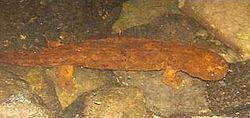| Cryptobranchoidea | |
|---|---|
 | |
| Cryptobranchus alleganiensis | |
 | |
| Hynobius fossigenus | |
| Scientific classification | |
| Kingdom: | Animalia |
| Phylum: | Chordata |
| Class: | Amphibia |
| Order: | Urodela |
| Suborder: | Cryptobranchoidea Dunn, 1922 |
| Subgroups | |
| |
The Cryptobranchoidea are a suborder of salamanders found in Asia, European Russia, and the United States. They are known as primitive salamanders, in contrast to Salamandroidea, the advanced salamanders. [1] It has two living subdivisions, Cryptobranchidae (Asian giant salamanders and hellbenders), and Hynobiidae, commonly known as Asian salamanders.
Giant salamanders are obligate paedomorphs with partial metamorphosis, [2] but Asiatic salamander goes through a full metamorphosis. The only known exceptions are the Longdong stream salamander, which has been documented as facultatively neotenic, and the Ezo salamander, where a now assumed extinct population from Lake Kuttarush in Hokkaido had neotenic traits like gills in adults. [3]
The oldest members of the group are known from the Middle Jurassic (Bathonian) aged Yanliao Biota of China. [4]